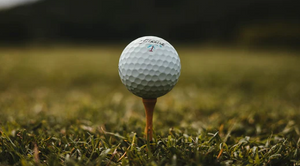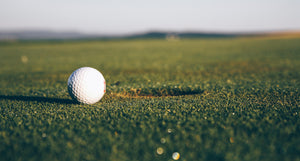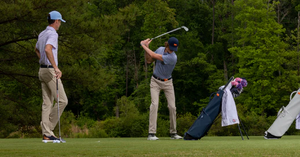What Are Blades in Golf?
The "blade" refers to a golf club head with an offset, square top that gives you better ball flight through the air. It has a thinner face than other irons for increased ball speed and extra distance. It’s the equipment seasoned players need to master their short game.
Blades provide accuracy and golf. Their unique shape differentiates them from other types of clubs. Here we’ll show how they compare to cavity backs and muscle backs and their suitability for pros and beginners.
What Is the Difference Between Blades and Cavity Backs?
Whether your aim is speed, precision, control, distance, or a club with more forgiveness, you’ll have your pick between blades and cavity backs.
Classic blades are thinner with a small sweet spot. The primary characteristic that differentiates a blade from other types of clubs is the size and shape of its head. Blades are generally more compact than other clubs, particularly those with larger heads. The shape makes them much easier to hit off the tee and into the fairway on par 3s and shorter holes. However, because they are more compact, they tend to be less forgiving than other clubs.
Cavity backs are bulkier, with a hollow section on the bottom. The larger size can make them more forgiving, but they also don't offer much control over the ball when you hit it. Another trade-off for this added forgiveness is that it is harder to make precision shots like chip shots or bunker shots with these clubs versus the accuracy you can achieve with classic blades.
Cavity-back irons were originally designed for low-handicap players who wanted more distance from their clubs. They became popular among recreational golfers who don't have the same demands for accuracy as professional golfers. The hollowed-out back cavity allows air to pass through the face at impact, producing a higher launch angle, greater ball speed, and more distance than other types.
When you set up for your shot, you’ll have to swing much faster with a blade than with other types of clubs to generate enough power to drive your ball farther. So, if you're playing from long distances off the tee or into hazards or rough areas, you may want to stick with muscle backs or cavity backs instead of blades.
If you want to improve your game without worrying about getting invited to play at Augusta National, you should stick with cavity backs. However, if you want nothing less than perfection from your golf equipment and pride yourself on placing every shot just where it needs to be—even when there's no room for error—consider investing in some blade irons.
What Is the Difference Between Blades and Muscle Backs?
Classic blades and muscle backs are two of the most popular blade types in professional golf. Classic blades are thin with a flexible steel face to give maximum ball speed. The club head is usually large and bulky to help increase distance but can also be smaller. The difference between a classic blade and a muscle back is that the former has a thinner profile, while the latter has more mass.
Muscle backs have a larger sweet spot than blades but smaller than cavity backs. They're less forgiving than cavity backs but more forgiving than blades. For many golfers, they're also more consistent than both blades and cavity backs.
Blades are typically for driving and long-range shots where accuracy is less important than distance. They tend to have larger clubheads than other clubs because of their high launch angle and low spin rate (spin rate is how much rotational velocity a golf ball has). A muscle back has a thicker top line than a classic blade and more offset, which makes it easier to hit from the center of the face.
Do Pro Golfers Use Blades?
Pro golfers use blades because they provide accuracy and control. Most pros can hit their shots exactly where they want them. They do this by having a clubface that is square at impact, which is only possible with blades. It’s also vital for pros to have a consistent swing path for each shot, which again comes down to having irons precisely fitted for their games.
While many pro golfers carry cavity back irons and muscle backs, some prefer hybrids to traditional clubs. Hybrids make up for any lost distance due to weaker lofts or shorter shaft lengths that aren’t available in most models from manufacturers like Callaway or Ping.
Some pros switch between hybrids, blades, and muscle backs. For example, professional golfer Rory McIlroy used to reach for hybrids instead of muscle backs because he believed they fit better his eye level lie angle. However, in 2021, he went back in time and returned to using the muscle-back blades that first helped him sign with TaylorMade.
Mcllroy is just one example where pros choose equipment based on personal preference rather than necessity because even though it may seem like having all three types would give players more options when out on the course. Ultimately it comes down to whether these particular choices work best with each player's style.
Should a Beginner Golfer Use Blades?
Blades are more difficult to hit than cavity backs because the narrow face will make it harder for you to get a nice square hit. They’re also more challenging to hit than muscle backs, which have a larger clubhead and wider sole, making it easier for beginners to make solid contact with the ball.
For beginners just starting, it would be best if you didn’t use classic blades right away—instead, stick with some other types of clubs or try out a cavity back until you get better at golf. It can take years of practice before a golfer can effectively control the ball flight needed to use classic blades.
Compared to muscle backs and classic blades, cavity backs have a larger sweet spot that may suit you better if you're new to the golf course. They're less precise than the muscle back and blade clubs, but they are much more forgiving. Also, cavity backs usually produce greater distance than classic blade and muscle back irons because they're easier to hit off-center shots.
Do Blade Golf Clubs Go Further?
Cavities and muscle backs do better at providing distance because they allow more loft on deeper shots. They can be helpful if you're trying to get an extra 30 yards on your drive into the green.
The classic blade is still popular with many golfers because it can be much easier to hit precise shots with higher trajectories. But the overall trend in golf club design has been toward larger club heads and deeper faces, leading to more distance on average.
Final Thoughts
As you can see, blades are a staple in golf. They’re most prevalent among professional players who want more control of their shots, but today they're also used by beginner golfers and recreational players who want to improve their game.
There are several golf clubs on the market, each with a different design and purpose. Golfers need to understand that no single type of club will work for every situation on the course. Instead, golfers should consider their physical and technical needs when choosing equipment.
And, of course, to protect your equipment, it’s crucial to invest in quality club headcovers and golf bags—shop STITCH today for golf equipment endorsed by the pros.


